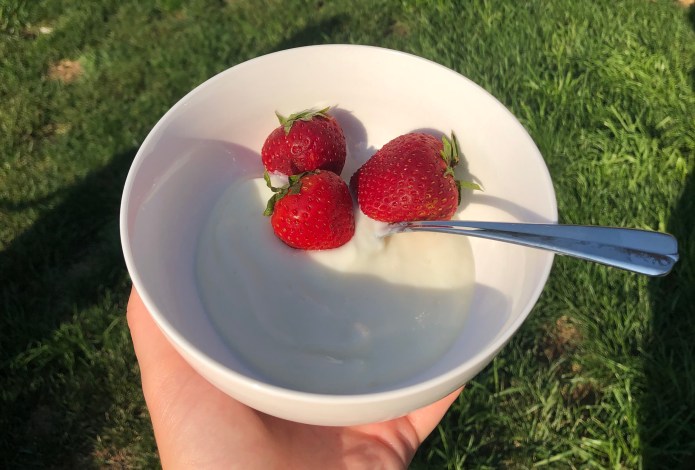California State University, Monterey Bay (CSUMB) and the Basic Needs Initiative program teamed up for their virtual weekly cooking demonstration on Sept. 24. Each Cooking with CSUMB tutorial follows faculty and staff recipes, providing Otters healthy, adaptable meal ideas suitable for each student’s busy schedule.
Assistant professor of marine science Sherry Palacios instructed students to make Greek yogurt from scratch. Palacios enthusiastically compared her love of cooking and science and explained how the two intertwine when making homemade Greek yogurt. When deconstructing the yogurt making process, Palacios mentioned one must have a close eye on temperatures and keep the work surface sterile. She also expressed the importance of following exact instructions when cooking, using the same procedures as participating in a science experiment.
Helping cut costs by eliminating the need to buy organic yogurt at the store, Palacios demonstrated how cooking can coincide with science and created a fun, educational experience.
The ingredients for the yogurt are fairly simple: one gallon of cow milk, two tablespoons of dry powdered milk and two tablespoons of yogurt from a previous batch.
Don’t have a previous batch? Palacios notes buying yogurt from the store can work as a temporary substitute until you begin making your own at home. One thing that can’t be substituted or skipped over is the pasteurization of cow milk.
“Pasteurized yes, ultra-pasteurized- no,” Palacios said.
Heating ultra-pasteurized milk causes it to cook, making it unsuitable for culturing. Palacios noted that paying close attention to temperatures throughout cooking is crucial for a successful batch. Failing to maintain proper temperatures can lead to a bad, uneatable yogurt.
Palacios believed following the Greek yogurt recipe is an enjoyable experiment requiring little effort but also attention to detail. Similar to a science project, the yogurt requires waiting a few days to get the best result.
What differentiates Greek yogurt from regular? Whey. Palacios led students through the process of straining the yogurt, which resulted in whey leaving the mixture and caused the yogurt to thicken.
No significant health benefits appear when choosing Greek yogurt over regular brands, but some may prefer the rich texture of Greek yogurt.
In addition to making greek yogurt, Palacios is efficient in upcycling. “You can use the strained whey to add to pasta water which kicks up the protein,” Palacios said.
Being an active runner, Palacios regularly indulges in ‘recovery bowls,’ which consist of a delicious concoction of homemade Greek yogurt, shredded apple, strawberries and blueberries. She encouraged viewers to whip up this any-time favorite to help restore their body’s essential nutrients after exercising.
Otters looking for a chance to follow along with scrumptious recipes can tune in weekly to watch more Basic Needs Initiative demonstrations. Each week students have the opportunity to win raffle prizes or $25 e-gift cards to purchase groceries. CSUMB and the Basic Needs Initiative are hosting a chipotle burrito bowl demonstration on Oct. 1.

